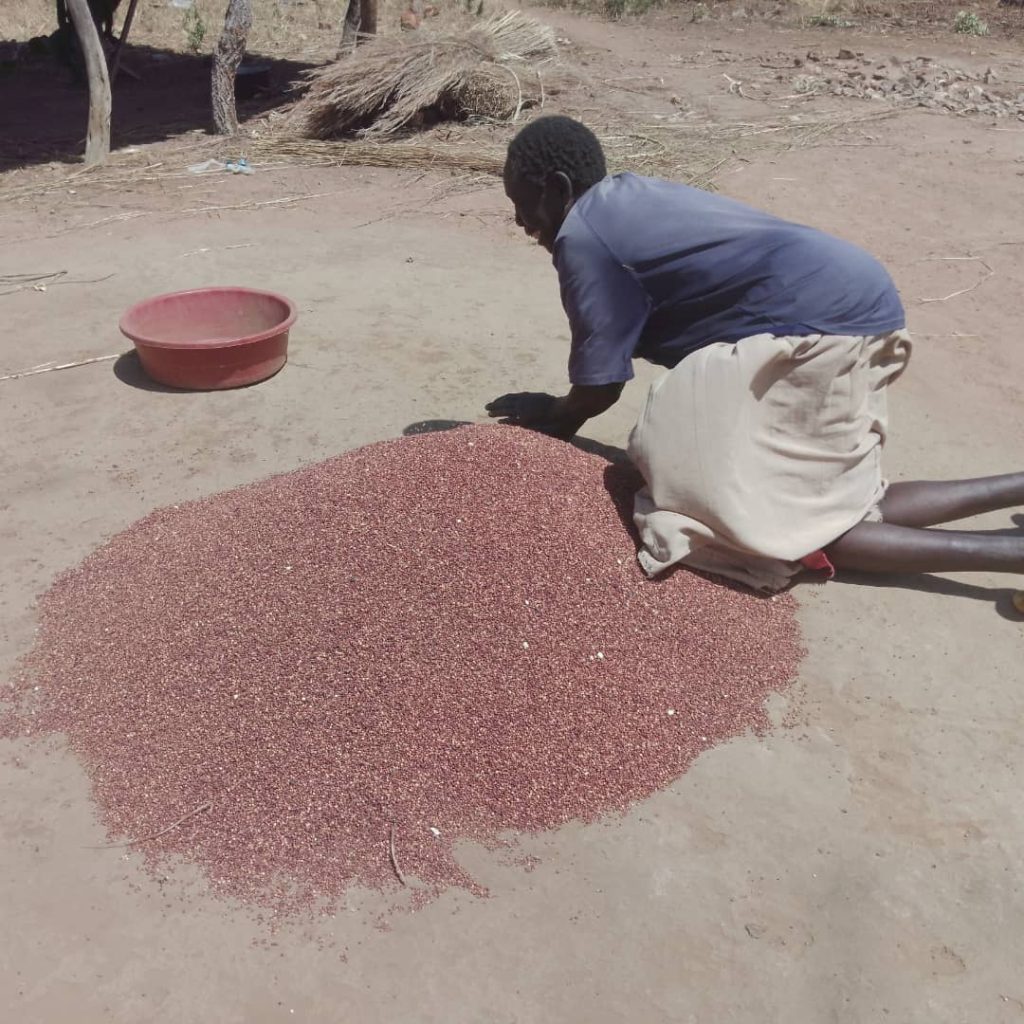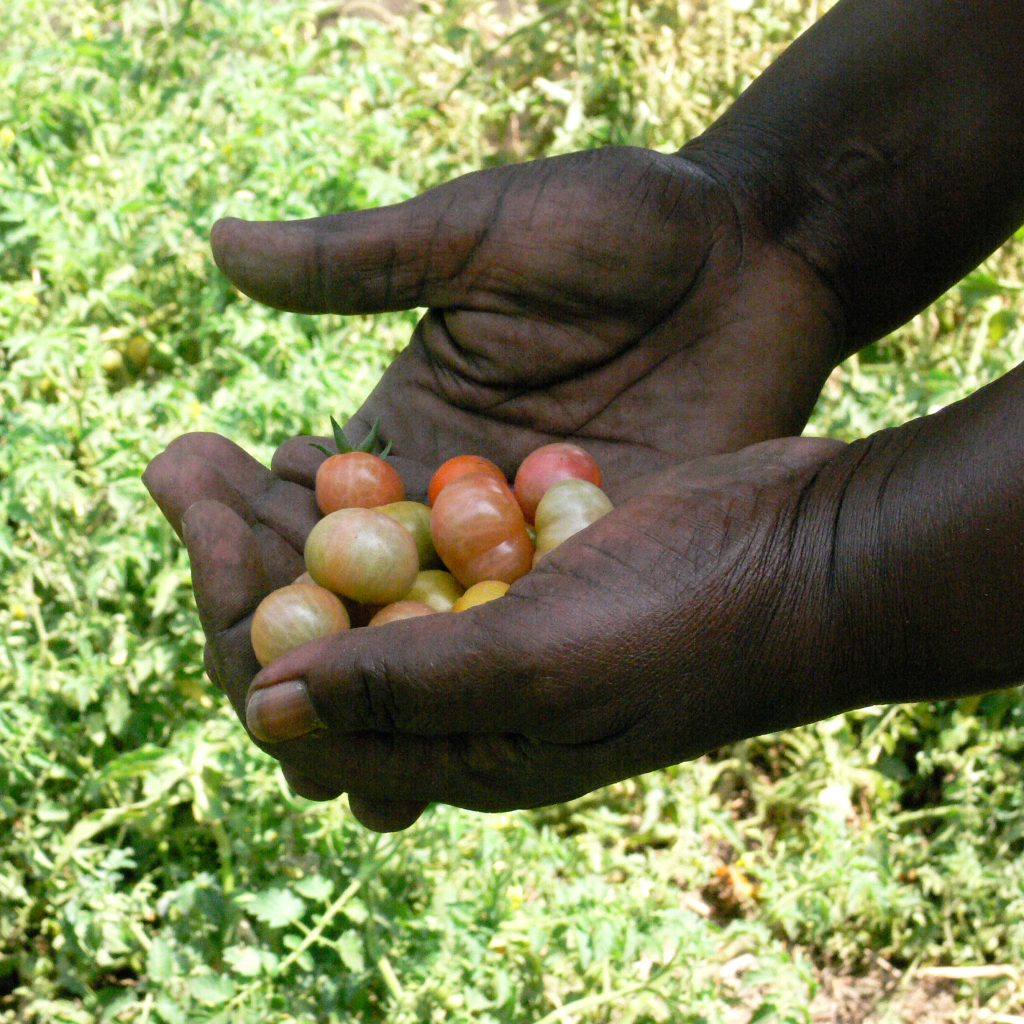By Justine Muboka
Hanging by Vicky Lukwiya’s fireplace are several stocks of indigenous seeds and grains like sorghum, millet and maize among others.

Lukwiya uses the fireplace in her kitchen at her home in Ariaga central, Laroo-Pece Division in Gulu city, to preserve her indigenous seeds for the next planting season.
“The fireplace keeps them warm and safe from weevils. Even though they are dry they can still be attacked by weevils because of the changes in the environment and the air,” she said.
She adds, “We also keep seeds and grains in gourds at the fireplace and they can last three years without them getting attacked by weevils. Our forefathers used to keep seeds like this in the gourds under the fireplace or out in the open.”
Lukwiya is the chairperson of local seed farmers in Gulu and Omoro district under the Eastern and Southern Africa Small-scale Farmers’ Forum-ESAFF, a Non-Governmental Organization that is implementing a Food Sovereignty project through resisting Genetically Modified Foods-GMOs.
The over 700 local seed farmers are currently constructing a seed bank at Ongako Sub county in Omoro district which they intend to use to store indigenous seeds.
“We are keeping indigenous seeds which are going to disappear. You disappear with seeds, there will be no food in homes. We call this community seed banks because it’s the community that collect the seeds. No one else,”
Lukwiya says its high time government incorporated indigenous seeds and crops when supplying to farmers.
“The cassava which government has been giving farmers takes six months to mature and it gets rotten leaving people in hunger so many rejected it and have gone back to indigenous cassava (okonyo-ladak) which takes two years to mature but you can keep harvesting it for three years, she said.”
Even though, it is dry season, Luwkiya is still harvesting green vegetables like amaranths, yams, spider plant (akeyo) and cow pea leaves from her small garden right in front of her kitchen.
At one time Uganda’s food basket, Acholi and Teso sub regions, are facing threats to food security, as the shift to improved seeds affects farmers ability to sustain production.
The need to buy planting material every season and unpredictable prices for farm produce means that many farmers may not earn enough to afford seed for the next crop.
For this reason, farmers like Lukwiya are going back to using indigenous seeds and food crops.
This eliminates the need to buy new seeds every other planting season, since farmers using indigenous seeds just have to dry some of their seeds which they can use to plant.
Jacqueline Akera is the treasurer of Can rwede pe, a farmer group in Labongo Guru Village, Oding parish, Unyama Sub County in Gulu district.
“With our local seeds, you can use them for planting, all you have to do is pick some seeds, dry and keep. When you plant the same seeds, they will still yield as highly as they did the first time as long as you plant, weed and harvest at the right time” she said.
The group of 51 members made up of mainly widows and other community members has for the last five years been using indigenous seeds to grow food crops for home consumption and sale.
These include millet, sorghum, traditional vegetables like pumpkins, cow pea, malakwang, akeyo and collard greens among others.
Can rwede pe was started as a saving group in 2018.
I visited the group recently and found out that they are growing several nutritious traditional seeds and crops.
The members even sundry the traditional vegetables which they consume during the dry season when they can’t grow fresh ones.
Akera says local seeds can be easily replicated compared to improved seeds.
“Many people go and buy collard greens locally known as Sukuma wiki from shops expensively but after planting, you cannot harvest any seeds which means they have to buy seeds every planting season” Akera said.
The members ventured into vegetable growing after finding difficulty in keeping up with weekly savings due to lack of cash.
“When we started weekly savings, there were weeks where members were unable to save because they did not have money. So we decided to find other ways of making money and decided to venture into vegetable growing. Vegetables like boo (cow pea) take two and half weeks for one to start harvesting and selling. This saved us from selling household food stuffs like sorghum and beans to get money for savings,” she said.
From selling the vegetables and indigenous seeds, the group managed to save 3.7 million shillings last year (2021) and is targeting to save 7 million shillings from indigenous vegetables in 2022.
Akera explains that growing crops using indigenous seeds has been advantageous to the group and opened up opportunities for them.
“Growing indigenous crops helped us during the coronavirus pandemic, health experts were advising people to eat vegetables to build immunity and these are foods we already had. We did not imagine Ker Kwaro Acholi- the Acholi Cultural Institution would ever come to our village to see our work and look for local seeds to perform cultural rites,” she said.
Ladoo Sarafina, the Chairperson of Can Rwede Pe group says they also support other women groups interested in growing indigenous seeds and crops.
“Women come to us for seeds that they don’t have, we give them for free but if they need a lot, we sell to them at a small fee,” Ladoo said.
The group has been storing their seeds and dried vegetables in polythene bags which they say is not ideal as the seeds easily get exposed to weevils.
They have now built a granary which they use to store their seeds.
Can Rwede Pe are a beneficiary of Promoting Women Land Rights and Local Seed Bank project of Gulu Women Economic Development and Globalization-GWED-G-a Non-Governmental Organization.
The project is funded by CivFund, a non-profit.
The 18bmonths project that ends in December 2022 aims is to change the food production and consumption patterns through training and raising awareness about indigenous seeds and crops.
Lucy Nyeko, the program officer says promoting women land rights and going back to growing indigenous seeds will in a long run reduce the cost of production, ensure food security and improved health among the population.
“When we promote the women land rights and go back to produce indigenous seed, it means our cost of production goes low. The local seeds that we produce don’t need chemicals. We are talking about green grams, sorghum, millet and vegetables. You can even dry, store them and still use it to plant,” she said.
Enabu Joseph Morris, a nutritionist at Soroti Regional Referral Hospital says indigenous foods were earlier produced for food purposes,
“Foods such as millet were produced by every household. It is one of the foods that have been cultivated for very many years.”
Enabu thinks that modified seeds can actually co-exist with traditional seeds to ensure that there is food security.
“In 1981, there was famine and communities managed to overcome it with traditional seeds. In 1983, a similar thing happened and that is when ministry of agriculture came up with modified seeds in order to resist some of the diseases that had affected some of our seeds. We need a lot of input from agricultural scientists in order to improve on the sustainability and resistance of our crops to pests and diseases.
Millet
Finger millet is one of the cereal crops that has been slowly disappearing from diets of many families-mainly because its production has reduced.

Statistics from Uganda Bureau of Statistics indicate that millet production dropped from 193,461 metric tons in 2016 to 70,000 metric tons in 2020.
Scovia Adikini, a senior research officer at the National Semi Arid Agricultural Research Institute, NASARI in Serere district says millet is a good food security crop that should be promoted by government
“In terms of food security, finger millet is one cereal that you can store for years without being damaged by any pests. Traditionally, communities that grew finger millet had granaries. Communities that grew finger millet in the past never used to run out of food,” she said.
In Teso sub region, some farmers are using both the indigenous and improved seed and crop variety.
Okiror Moses, the senior Agriculture Officer Soroti district explains that indigenous seeds are on a decline for various reasons such as introduction of improved seeds which are high yielding and low market value.
“Introduction of improved seeds has suppressed traditional seeds. Some of these indigenous food crops have very low market prices and this has caused their decline in the sub region.
Ikaelen Agnes is a farmer from Otapengo village, Maseniko Sub County in Kapelebyong district.
She says, “I plant both indigenous and improved seed varieties for example when I am planting ground nuts I plant the indigenous seeds because I know that they can withstand drought but I also plant the new variety because they might also be good,” Ikaelen said.
Indigenous vegetables and grains are on the verge of extinction as they are slowly being replaced with improved crop varieties.
This has a direct effect on nutrition.
Between 2013 and 2015, more than 500,000 young Ugandan children died, according to UNICEF.
Of these deaths, nearly half were associated with undernutrition.
But a Ministry of Health Nutrition Action Plan 2011- 2016 report titled “End Malnutrition Now” recommends for promoting production and consumption of indigenous foods to enhance dietary diversification.
The report states that Uganda loses US$310 million worth of productivity per year due to the high levels of stunting, iodine-deficiency disorders, iron deficiency, and low birth weight, and malnutrition contributes to a loss of about 4.1 percent of the gross domestic product.
The Food and Agricultural Organization-FAO supports the promotion of community seed banks as a system that communities can adopt to store and manage regular seed needs.
According to FAO, the system can also help farmers to acquire varieties adapted to local conditions, but which the costs may not be accessible in formal seed markets.
Increasing the resilience of livelihoods to threats and crises is one of the strategic objectives of FAO (Strategic Objective 5, or SO5), where it is crucial to increase resilience regarding agriculture and food and nutrition security, sectors that are among the most severely affected by natural threats.
In October 2021, the National Agricultural Research Organization-NARO came out with standard Operating Procedures for establishment of community seed bank in Uganda, the first of its kind.
Ambrose Agona, the Director General NARO says the SOPs serve to technically guide stakeholders on how to establish a functional community seed bank
This reporting was supported by the International Women’s Media Foundation’s Gender Justice Reporting Initiative.
(This story was first published by Mega Fm in 2022)


